The Fitness Zone

Top Fitness Trends for 2020
If you own a Fitbit, Apple Watch or another kind of wearable technology to track your fitness, you’re already following the number-one predicted fitness trend for 2020 – wearable technology! Wearable tech has topped the list 4 times in the last 5 years, according to the American College of Sports Medicine’s (ACSM) annual fitness trend forecast and we don’t expect it to be slowing down any time soon.
In 2020, more people than ever are using wearable technology to track their daily steps, calories burnt and time spent sitting vs standing; all with the goal to be their best, healthiest self. There are a predicted 835 million people who will be utilising these devices in 2020, with expectations for this number to hit 1 billion by 2022.
As a fitness professional, it is important to know what to expect coming into the year ahead, so you can make the necessary tweaks to your offerings to ensure your business stays relevant. Simply staying in the loop with what people in the industry are interested in, talking about or seeking, will keep you one step ahead and ready to seize any opportunity that the new year throws at you.
Now in its 14th year, the fitness trends survey was completed by more than 3,000 health and fitness professionals worldwide, and was designed to reveal trends in various fitness environments. 36 potential trends were given as choices, and the top 20 were ranked and published by ACSM.
THE ACSM TOP 10 FITNESS TRENDS FOR 2020 ARE:
1. Wearable Technology: includes activity trackers, smart watches, heart rate monitors and GPS tracking devices.
2. High-Intensity Interval Training (HIIT): HIIT, which involves short bursts of activity followed by a short period of rest or recovery, these exercise programs are usually performed in less than 30 minutes.
3. Group Training: Group exercise instructors teach, lead and motivate individuals through intentionally designed group exercise classes. Group programs are designed to be motivational and effective for people at different fitness levels, with instructors using leadership techniques that help individuals in their classes achieve fitness goals.
4. Training with free weights: previously described as “strength training” this category changed titles to be more specific, now referring to exercises using free weights, barbells, kettlebells and medicine balls.
5. Personal Training: Personal training includes fitness testing and goal setting with the trainer working one on one with a client to prescribe workouts specific to clients’ individual needs and goals. This includes online, in health clubs, in the home, and in worksites that have fitness facilities.
6. Exercise is Medicine. Exercise is Medicine is a global health initiative that is focused on encouraging primary care physicians and other health care providers to include physical activity when designing treatment plans for patients and referring their patients to exercise professionals.
7. Body Weight Training: Body weight training uses minimal equipment making it more affordable. Not limited to just push-ups and pull-ups, this trend allows people to get “back to basics” with fitness.
8. Fitness programs for older adults: People are living longer, working longer, and remaining healthy and active much longer, so the trend of fitness programs for older adults is becoming more and more prevalent.
9. Health/wellness coaching: A one-on-one or small group approach, in which the values, needs, goals and visions are focused on by the coach to provide support, guidance and behavior changing intervention strategies.
10. Employing certified fitness professionals: the importance of hiring certified health fitness professionals through educational programs and certification programs that are fully accredited for health fitness professionals.
Read more articles
Disclaimer: Where Certificate III in Fitness, Cert III/Cert 3, or Fitness Coach is mentioned, it refers to SIS30321 Certificate III in Fitness. Where Certificate IV in Fitness, Cert IV/Cert 4, or Personal Trainer is mentioned, it refers to SIS40221 Certificate IV in Fitness. Where Master Trainer Program™ is mentioned, it refers to Fitness Essentials and SIS40221 Certificate IV in Fitness. Where Master Trainer Plus+ Program™ is mentioned, it refers to SIS30321 Certificate III in Fitness and SIS40221 Certificate IV in Fitness. Where Certificate IV in Massage or Cert IV/Cert 4 is mentioned, it refers to HLT42021 Certificate IV in Massage Therapy. Where Diploma of Remedial Massage is mentioned, it refers to HLT52021 Diploma of Remedial Massage.











